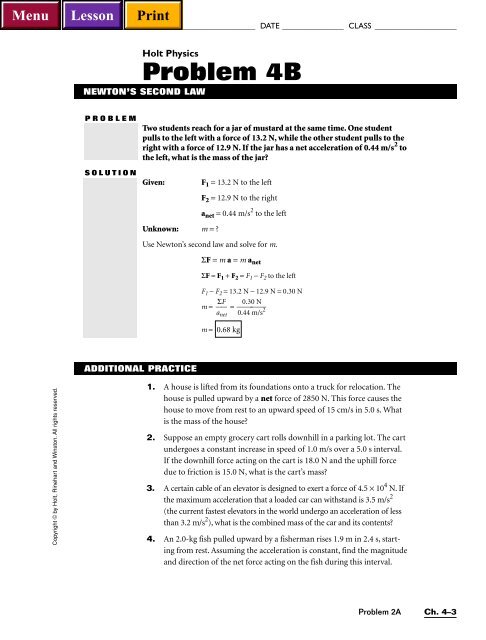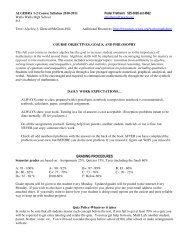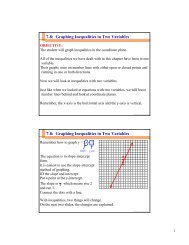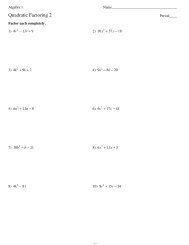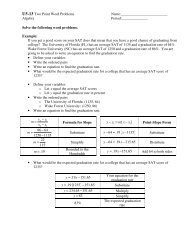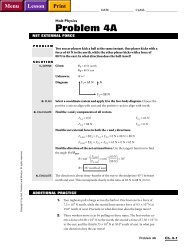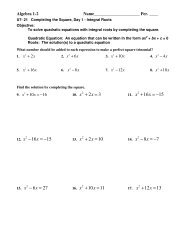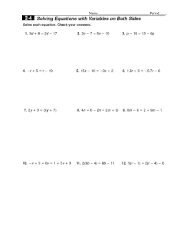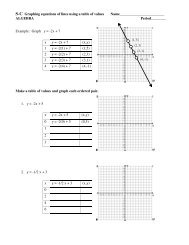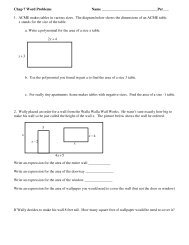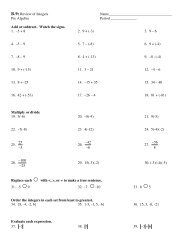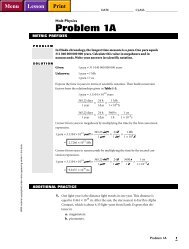Problem 4B - Newton's Second Law
Problem 4B - Newton's Second Law
Problem 4B - Newton's Second Law
- No tags were found...
Create successful ePaper yourself
Turn your PDF publications into a flip-book with our unique Google optimized e-Paper software.
NAME ______________________________________ DATE _______________ CLASS ____________________Holt Physics<strong>Problem</strong> <strong>4B</strong>NEWTON’S SECOND LAWPROBLEMSOLUTIONTwo students reach for a jar of mustard at the same time. One studentpulls to the left with a force of 13.2 N, while the other student pulls to theright with a force of 12.9 N. If the jar has a net acceleration of 0.44 m/s 2 tothe left, what is the mass of the jar?Given:Unknown: m = ?F 1 = 13.2 N to the leftF 2 = 12.9 N to the righta net = 0.44 m/s 2 to the leftUse Newton’s second law and solve for m.ΣF = m a = m a netΣF = F 1 + F 2 = F 1 − F 2 to the leftF 1 − F 2 = 13.2 N − 12.9 N = 0.30 NΣF0.30 Nm = ⎯⎯ = ⎯⎯a 0. 44m/s 2netm =0.68 kgADDITIONAL PRACTICECopyright © by Holt, Rinehart and Winston. All rights reserved.1. A house is lifted from its foundations onto a truck for relocation. Thehouse is pulled upward by a net force of 2850 N. This force causes thehouse to move from rest to an upward speed of 15 cm/s in 5.0 s. Whatis the mass of the house?2. Suppose an empty grocery cart rolls downhill in a parking lot. The cartundergoes a constant increase in speed of 1.0 m/s over a 5.0 s interval.If the downhill force acting on the cart is 18.0 N and the uphill forcedue to friction is 15.0 N, what is the cart’s mass?3. A certain cable of an elevator is designed to exert a force of 4.5 × 10 4 N. Ifthe maximum acceleration that a loaded car can withstand is 3.5 m/s 2(the current fastest elevators in the world undergo an acceleration of lessthan 3.2 m/s 2 ), what is the combined mass of the car and its contents?4. An 2.0-kg fish pulled upward by a fisherman rises 1.9 m in 2.4 s, startingfrom rest. Assuming the acceleration is constant, find the magnitudeand direction of the net force acting on the fish during this interval.<strong>Problem</strong> 2A Ch. 4–3
NAME ______________________________________ DATE _______________ CLASS ____________________5. An 8.0-kg bag of coins is being pulled upward by a rope rises 20.0 cmin 0.50 s, starting from rest. Assuming the acceleration is constant, calculatethe net force on the bag. What is the upward force on the bag exertedby the rope?6. A pedestrian with a mass of 75 kg accelerates at 0.15 m/s 2 to the west.A high wind comes up, blowing toward the east. The wind is capable ofgiving the pedestrian an acceleration of 2 × 10 −2 m/s 2 . What are themagnitude and direction of the net force acting on the pedestrian?7. Assume that a catcher in a professional baseball game exerts a force of−65.0 N to stop the ball. If the baseball has a mass of 0.145 kg, what isits net acceleration as it is being caught?8. A 214 kg boat is sinking in the ocean. The boat’s weight is partially offsetby the 790 N buoyant force of the water. What is the net accelerationof the boat?9. The Goliath beetle, which is found in Africa, can reach a mass of0.080 kg. Suppose a Goliath beetle is placed on a slope that makes anangle of 37.0° with the horizontal. Find the acceleration of the beetlealong the slope, assuming the slope to be frictionless.10. If an force of 1.40 N upward along the slope is applied to the beetle inproblem 9, what is the beetle’s acceleration?Copyright © by Holt, Rinehart and Winston. All rights reserved.Ch. 4–4Holt Physics <strong>Problem</strong> Bank
Additional Practice <strong>4B</strong>Givens1. F net = 2850 Nv f = 15 cm/sv i = 0 cm/s∆t = 5.0 sSolutionsv f − v 15 cm/s − 0 cm/sa net = ⎯ i= ⎯⎯ = 3.0 cm/s 2 = 3.0 × 10 −2 m/s 2∆t5.0 sF net = m a netF net 2850 Nm = ⎯ = ⎯⎯3.0 × 10 −2 m/s 2anetm = 9.5 × 10 4 kg2. ∆t = 1.0 m/s∆t = 5.0 sF downhill = 18.0 NF uphill = 15.0 N∆v 1.0 m/sa net = ⎯ = ⎯ =0.20 m/s 2∆t 5.0 sF net = m a net = F downhill − F uphill = 18.0 N − 15.0 N = 3.0 NF net 3.0 Nm = ⎯ = ⎯ = 15 kg0.20 m/s2anet3. F max = 4.5 × 10 4 Na net = 3.5 m/s 2g = 9.81 m/s 2F net = m a net = F max − mgm(a net + g) = F maxF 4.5 × 10 4 N 4.5 × 10 4 Nm = ⎯ max= ⎯⎯⎯ = ⎯⎯ = 3.4 × 10 3 kg13.3 m/s23.5 m/s 2 + 9.81 m/s 2anet + g4. m = 2.0 kg∆y = 1.9 m∆t = 2.4 sv i = 0 m/s1∆y = v i ∆t + ⎯ a net ∆t 222∆y (2)(1.9 m)Because v i = 0 m/s, a net = ⎯ = ⎯⎯ = 0.66 m/s 2∆t2 (2.4 s)2F net = m a net = (2.0 kg)(0.66 m/s) = 1.32 NF net =1.32 N upwardCopyright © by Holt, Rinehart and Winston. All rights reserved.5. m = 8.0 kg1∆y = v i ∆t + ⎯ a net ∆t 22g = 9.81 m/s 2 F net = 13 N upward∆y = 20.0 cm2∆y (2)(20.0 × 10 −2 m)∆t = 0.50 sBecause v i = 0 m/s, a net = ⎯ = ⎯⎯∆t2 (0.50 s)2 = 1.6 m/s 2v i = 0 m/sF net = m a net = (8.0 kg)(1.6 m/s 2 ) = 13 NF net = F upward − mgF upward = F net + mg = 13 N + (8.0 kg)(9.8 m/s 2 ) = 13 N + 78 N = 91 NF upward = 91 N upward6. m = 75 kga forward = 0.15 m/s 2 westa backward = 2 × 10 −2 easta net = a forward − a backward = 0.15 m/s 2 − 2 × 10 −2 m/s 2a net = 0.13 m/s 2 westF net = m a net = (75 kg)(0.13 m/s) = 9.8 NF net = 9.8 N westVSection Five—Solution Manual V Ch. 4–3
Givens7. F net = −65.0 Nm = 0.145 kgSolutionsF −65.0 Na net = ⎯ net= ⎯ = −448 m/s 2m 0.145 kg8. m = 214 kgF net = F buoyant − mg = 790 N − (214 kg)(9.81 m/s 2 )F buoyant = 790 Ng = 9.81 m/s 2 F net = 790 N − 2.10 × 10 3 N = −1310 NF −1310 Na net = ⎯ net= ⎯ = −6.12 m/s 2m 214 kg9. m = 0.080 kgF net = m a net = m g(sin q)q = 37.0°a net = g(sin q) = (9.81 m/s 2 )(sin 37.0°) = 5.90 m/s 2g = 9.81 m/s 2a net = 5.90 m/s 2 down the incline (37.0° below horizontal)10. m = 0.080 kgF upward = 1.40 Na downward = 5.90 m/s 2F net = F upward − m a downward = 1.40 N − (0.080 kg)(5.90 m/s 2 ) = 1.40 N − 0.47 N = 0.93 NF net = 0.93 N up the incline (37.0° above the horizontal)a net = F net 0.93N⎯⎯ = ⎯⎯ = 12 m/s 2m 0 .080kgAdditional Practice 4C1. F downward = 4.26 × 10 7 Nm k = 0.25F net = F downward − F k = 0F k = m k F n = F downwardF 4.26 × 10 7 NF n = ⎯ downward= ⎯⎯ = 1.7 × 10 8 Nmk 0.25V2. F n = 1.7 × 10 8 NF n = mg (cos q)q = 10.0°F 1.7 × 10 8 Ng = 9.81 m/s 2 m = ⎯ n= ⎯⎯⎯ = 1.8 × 10 7 kgg (cos q) (9.81 m/s 2 )(cos 10.0°)3. F s,max = 2400 Nms = 0.20q = 30.0°g = 9.81 m/s 24. m = 60.0 kga = 3.70 m/s 2ms = 0.455g = 9.81 m/s 2F s,max = m s F nF 2400 NF n = ⎯ s,max= ⎯ = 1.2 × 10 4 Nms 0.20F n = 1.2 × 10 4 N perpendicular to and away from the inclineF n = mg(cos q)F 1.2 × 10 4 nNm = ⎯ = ⎯⎯⎯ = 1400 kgg (cos q) (9.81 m/s 2 )(cos 30.0°)For the passenger to remain standing without sliding,F s,max ≥ F = maF s,max = m s F n = m s mgm s mg ≥ mam s g ≥ a(0.455)(9.81 m/s 2 ) = 4.46 m/s 2 > 3.70 m/s 2Copyright © by Holt, Rinehart and Winston. All rights reserved.The passenger will be able to stand without sliding.V Ch. 4–4Holt Physics Solution Manual


